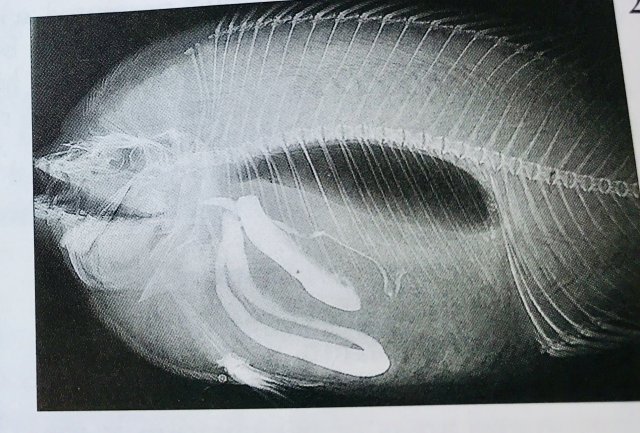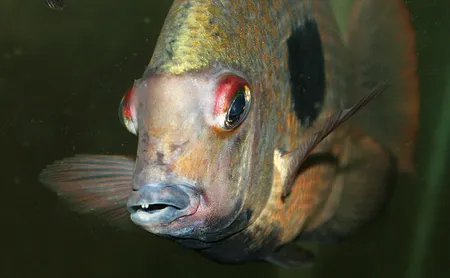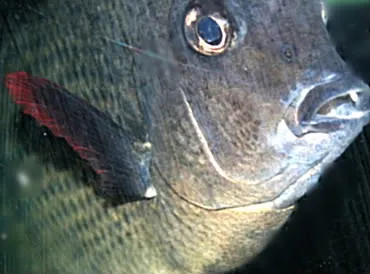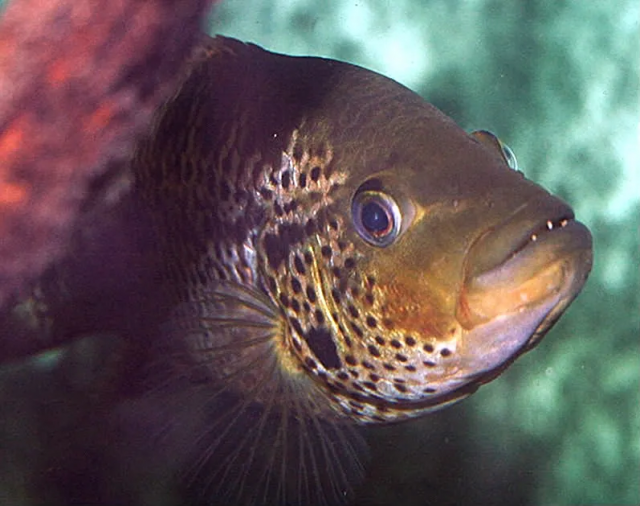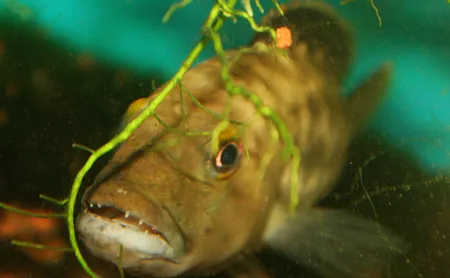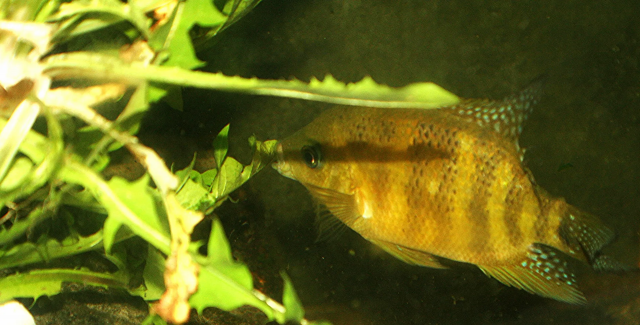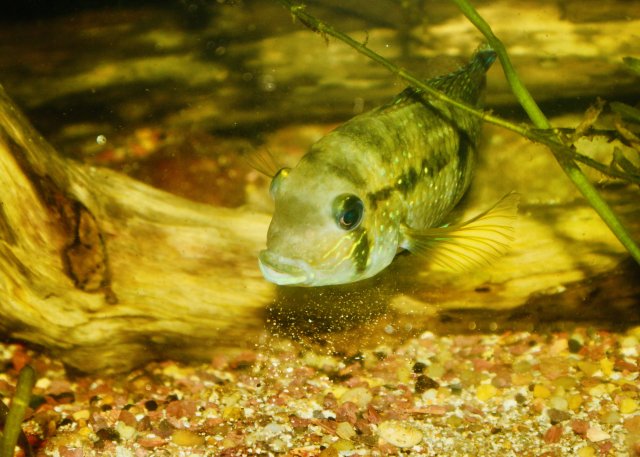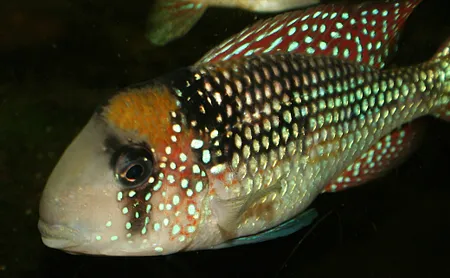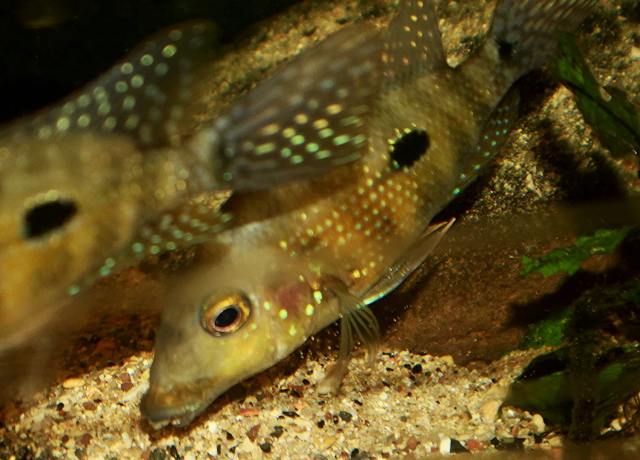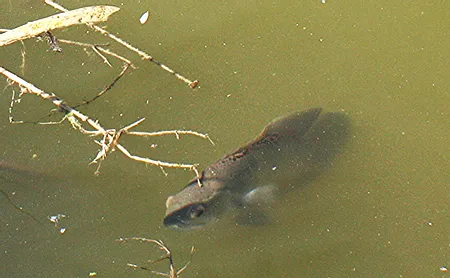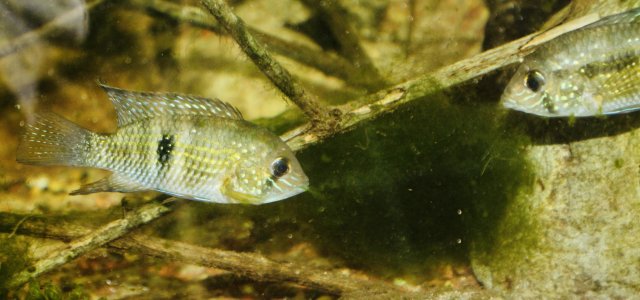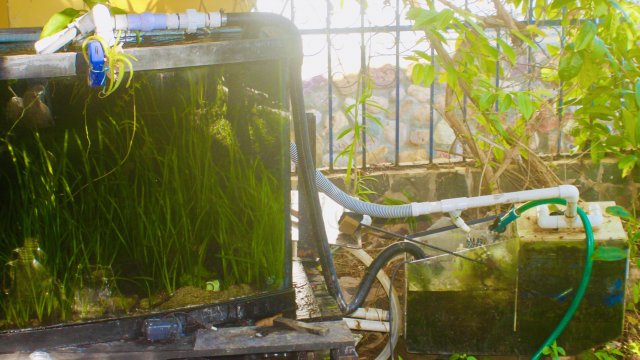They are all predatory meat eaters.
Most Central Americans are omnivores meaning they get a large chunk of their diet from algae, detritus, and other plant type foods.
Cichlids like Rocio (JDs, the Herichthys carpintus group, and many Amatitlania (convict type)) spend much of their day grazing on algae, and detritus, getting that plant based diet, along with a little extra protein from the small animals that live in it.
Some Central Americans, the genera Cincelichthys, Isthmoheros, and some Vieja are primarily vegetarian, eating fallen fruit, leaf littler, higher aquatic and terrestrial plants, and algae.
Vieja maculacauda are even know to enter the ocean to graze on nutrient rich marine (salt water) algae.
Whenever you see a disc shaped, and rather round flat cichlid, it is apparent they cichlids are not built to be a predator, and their mouth shape and type of teeth coincide with those meant to graze on plants.
Similarly, the South American genera like Heros, and Uaru, or the Indian cichlid Etroplus suratensus are also, largely vegetarian in nature.
The genera Parachromis, Petenia, and Caquetaia, are the true carnivorous Central American predators. Built and shaped for speed to chase down prey, with a mouth apparatus for grabbing and holding prey, or as in the case with Petenia, extended jaw projection ability used to suck in that prey.
Yet even P. dovii have been found as adults, (when stomach contents have been analyzed) to be filled with 50% insects.
Another misconception that coincides with the above, is that because cichlids have large mouths, they need large pellets, or large chunks of flesh.
Especially with the clades considered eartheaters, such as Thorichthys, Cribroheros, and Geophagines (mostly S American) but represented in Central America by Geophagus crassilabrus, these fish take large mouthfuls of substrate, but sift out small, larval insects, mollusks, and worms, to ingest, and may have trouble with large objects often provided.
Another common misconception……
All cichlids are inherently aggressive.
Although some tend to be more aggressive than others, no matter what space is afforded, even large spaces.
Aggression is almost always (with a few exceptions) dependent on tank size.
If given the proper space, aggression usually is not an issue.
While an aquarist may perceive a 55 or 75 gallon glass box as a large body of water, these are about the size of a truck tire rut in the road, and one does not find cichlids living in those size puddles.
And consider beside simple space available, is that some species, like Nandopsis haitiensus which is the only cichlid endemic to its island habitat, or Mayaheros beanii, the only cichlid endemic to its northwestern Mexico rivers, may be a poor additions to a cichlid community tanks, because these loners see any other similar cichlid species , as a territorial threat.
Attaching a term like my fish is a “psycho”, is not relevant, because that fish is doing what instinct tells it to do. It’s not the fishes fault, it’s the aquarist fault for not providing the right space, or trying to put species together that probably shouldn’t be combined.
A common adage i see tossed about lately is
All New world cichlid need soft water
Most Central American waters are not soft.
A pH of 8-9 is not unusual in waters from Panama north into Mexico.
These waters are often highly mineralized and alkaline.
This is one of the reasons combining soft water Amazon basin species, like Oscars, or Uaru, with hard water Central Americans like Vieja or Herichthys can be problematic (not to mention the different space and territorial requirements.
Another related misconception.
All Central American species are loners, and should be kept as individuals
A number of Central Americans are shoaling species in nature.
Thorichthys, and Cribroheros are such species, and don’t do as well in pairs, or as a single individual in a mixed species cichlid community, as they would do as a single species group, in a large enough tank to hold a number of fish.
Most Central Americans are omnivores meaning they get a large chunk of their diet from algae, detritus, and other plant type foods.
Cichlids like Rocio (JDs, the Herichthys carpintus group, and many Amatitlania (convict type)) spend much of their day grazing on algae, and detritus, getting that plant based diet, along with a little extra protein from the small animals that live in it.
Some Central Americans, the genera Cincelichthys, Isthmoheros, and some Vieja are primarily vegetarian, eating fallen fruit, leaf littler, higher aquatic and terrestrial plants, and algae.
Vieja maculacauda are even know to enter the ocean to graze on nutrient rich marine (salt water) algae.
Whenever you see a disc shaped, and rather round flat cichlid, it is apparent they cichlids are not built to be a predator, and their mouth shape and type of teeth coincide with those meant to graze on plants.
Similarly, the South American genera like Heros, and Uaru, or the Indian cichlid Etroplus suratensus are also, largely vegetarian in nature.
The genera Parachromis, Petenia, and Caquetaia, are the true carnivorous Central American predators. Built and shaped for speed to chase down prey, with a mouth apparatus for grabbing and holding prey, or as in the case with Petenia, extended jaw projection ability used to suck in that prey.
Yet even P. dovii have been found as adults, (when stomach contents have been analyzed) to be filled with 50% insects.
Another misconception that coincides with the above, is that because cichlids have large mouths, they need large pellets, or large chunks of flesh.
Especially with the clades considered eartheaters, such as Thorichthys, Cribroheros, and Geophagines (mostly S American) but represented in Central America by Geophagus crassilabrus, these fish take large mouthfuls of substrate, but sift out small, larval insects, mollusks, and worms, to ingest, and may have trouble with large objects often provided.
Another common misconception……
All cichlids are inherently aggressive.
Although some tend to be more aggressive than others, no matter what space is afforded, even large spaces.
Aggression is almost always (with a few exceptions) dependent on tank size.
If given the proper space, aggression usually is not an issue.
While an aquarist may perceive a 55 or 75 gallon glass box as a large body of water, these are about the size of a truck tire rut in the road, and one does not find cichlids living in those size puddles.
And consider beside simple space available, is that some species, like Nandopsis haitiensus which is the only cichlid endemic to its island habitat, or Mayaheros beanii, the only cichlid endemic to its northwestern Mexico rivers, may be a poor additions to a cichlid community tanks, because these loners see any other similar cichlid species , as a territorial threat.
Attaching a term like my fish is a “psycho”, is not relevant, because that fish is doing what instinct tells it to do. It’s not the fishes fault, it’s the aquarist fault for not providing the right space, or trying to put species together that probably shouldn’t be combined.
A common adage i see tossed about lately is
All New world cichlid need soft water
Most Central American waters are not soft.
A pH of 8-9 is not unusual in waters from Panama north into Mexico.
These waters are often highly mineralized and alkaline.
This is one of the reasons combining soft water Amazon basin species, like Oscars, or Uaru, with hard water Central Americans like Vieja or Herichthys can be problematic (not to mention the different space and territorial requirements.
Another related misconception.
All Central American species are loners, and should be kept as individuals
A number of Central Americans are shoaling species in nature.
Thorichthys, and Cribroheros are such species, and don’t do as well in pairs, or as a single individual in a mixed species cichlid community, as they would do as a single species group, in a large enough tank to hold a number of fish.



